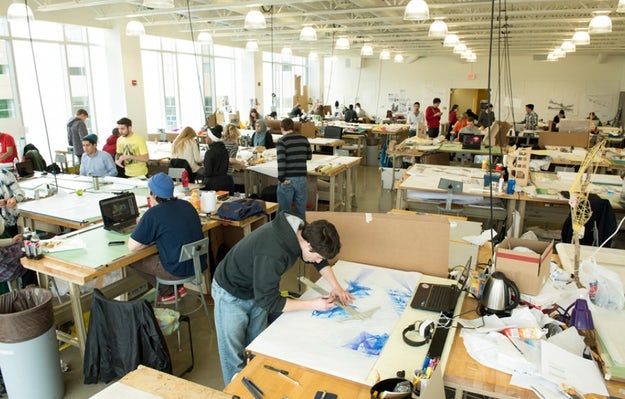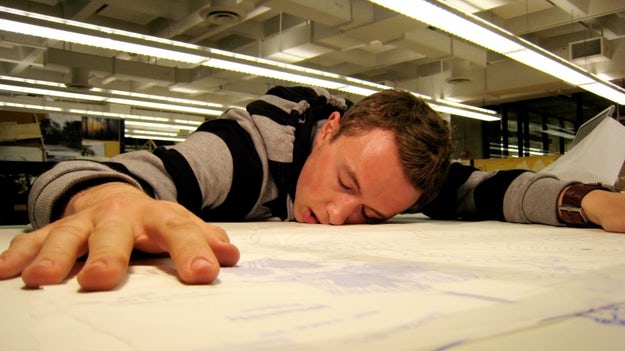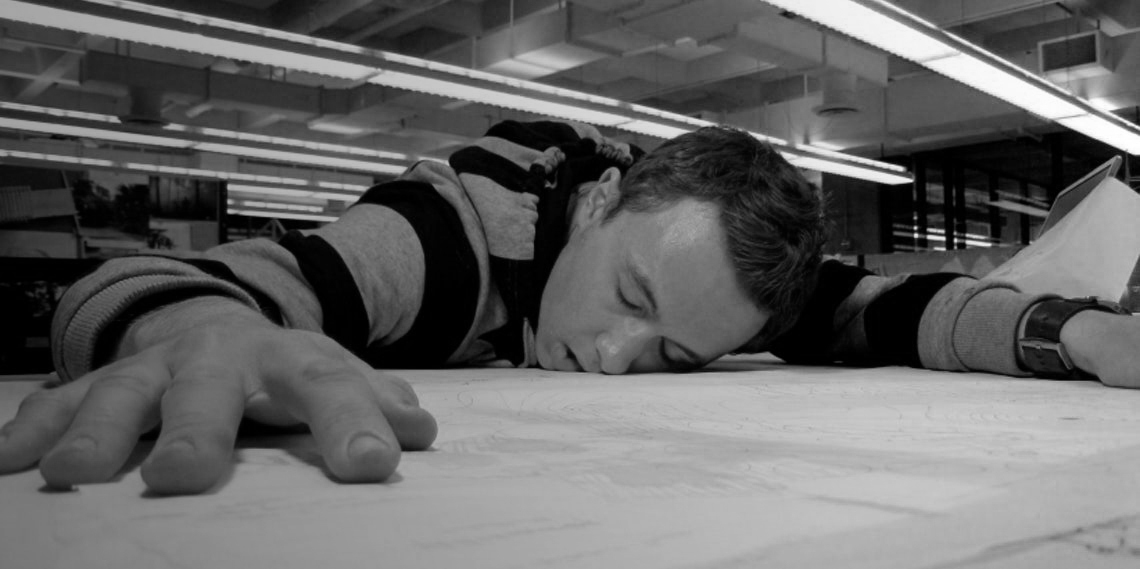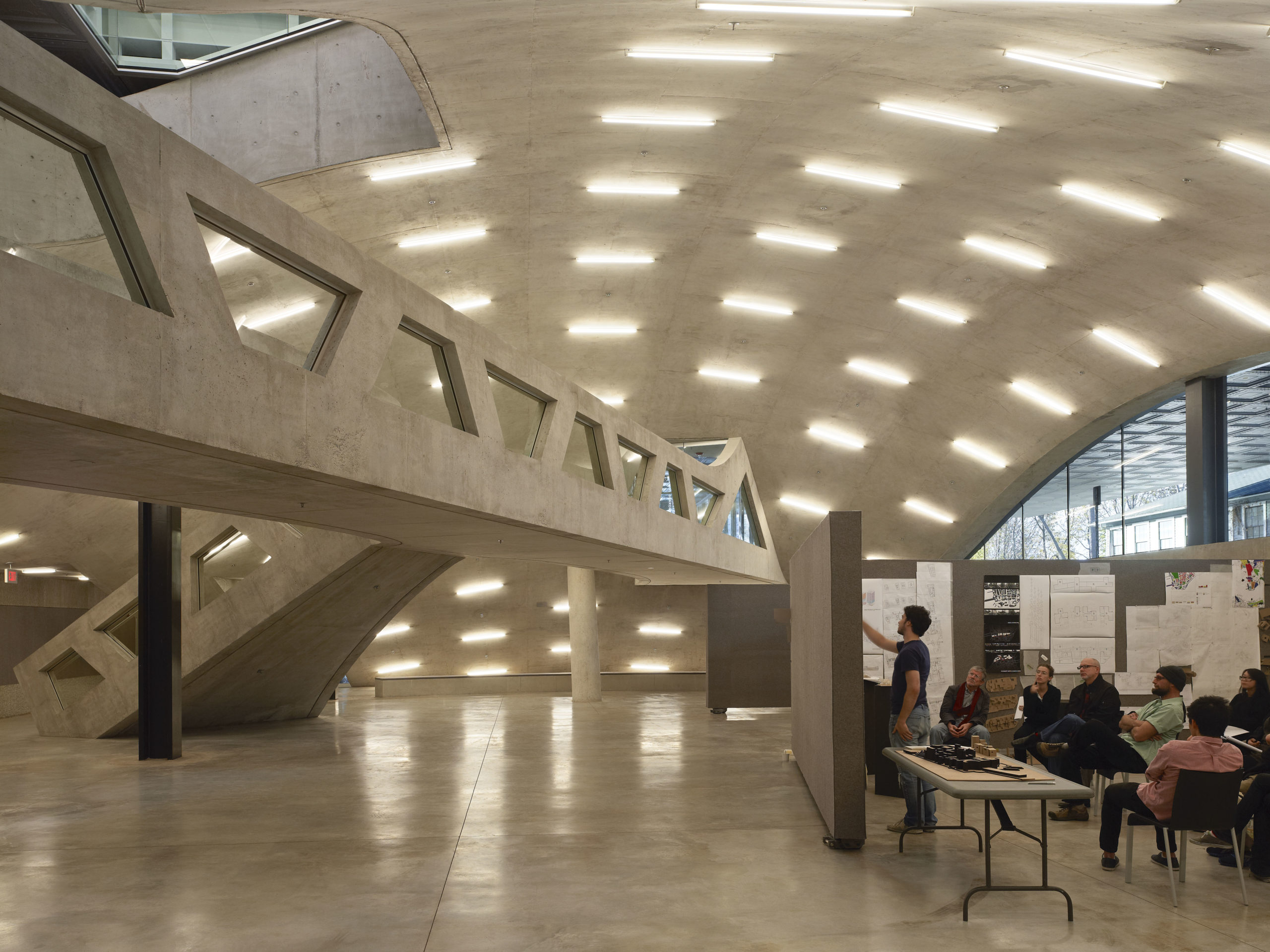Mike LaValley is the architect, speaker, and writer behind Evolving Architect. For more creative and nerdy insights, follow him on Instagram or check out his upcoming book.
Overwork and looming deadlines have elevated stress levels and inefficiency at the office to unprecedented heights throughout the profession. Burnout has reached critical levels throughout the workforce, hitting the architectural profession in particular. Looming deadlines and stress have begun to erode office efficiency and motivation. When we are burnt out at work, we often neglect it and push through, resulting in many long-lasting, negative effects over time.
Understanding burnout is the power to choose a different path.
Let’s get a better understanding of what burnout looks like as well as a tangible plan for how to improve the harmony between them. Burnout begins with recurring stress in the workplace and ends with a plan of how to defeat it.

Image via Evolving Architect
What is Burnout?
To understand the problem, we first need to define Burnout. So, what is Burnout exactly?
Well, the answer is intuitive, but nuanced. At its core, “Burnout” is the result of long term stress built up over time, ultimately overwhelming the person who experiences it. That said, burnout is NOT the same as stress. Stress is acute, while Burnout is chronic.
Everyone experiences a varying amount of stress on a daily basis. The difference here is that stress can be relieved at the source by either solving the problem causing the stress directly or by releasing stress through activities such as exercise. Burnout on the other hand is constructed, built up. The ability to break burnout down and get back to ‘normal’ or a baseline is much more difficult.
“Burnout is the physical or mental collapse caused by overwork or stress.” —Heidi Hanna, Ph.D., Executive Directory of the American Institute of Stress
When you’re experiencing stress, you can become temporarily bewildered or frustrated with something. But the moment is fleeting. It will pass.
When you’re experiencing burnout, you don’t have the ability quickly bounce back because the problems you need to deal with are systemic, not acute. Dealing with burnout requires you to untangle the mess, not just wait for it to pass. It won’t unless you change the systems that got you there.
Burnout exhausts you both physically and mentally. It can act as a gateway to other, more serious conditions such as depression, anxiety, and so on.
Do More.
Everyone is busy. When I say that, it probably either energizes you or makes you cringe. It’s possible it even does both. Since the recession in 2008, things have been progressively getting better in the economy [editor’s note: this post was originally written before the 2020 pandemic]. New technologies have been popping up left and right to help streamline the progress of society.
So, when everything’s good, it’s all good, right?
No.
We live in a time when ‘Do More’ and ‘Hustle’ culture are synonymous with success. While, yes, doing more and having a good work ethic can help close the gap between where you are and where you want to be in your career, they are not the only factors. You can’t sprint the entire length of a marathon. You have to methodically build yourself up so that your body and mind can adjust to the long term stresses you put them through.
But, society doesn’t care about that.
Society says, ‘Do More.’
Clients are moving forward with their building projects and we have to be there to serve them at the same levels of high quality as ever before. More clients appear and deserve the same.
More.
More.
More.
How do we cope? How do we keep up?
We show up harder. We become more efficient. We offer more services.
We do more.
Workplace or Everything?
In Spring 2019, the World Health Organization (WHO) addressed burnout head on. They have essentially categorized burnout as a ‘workplace’ condition. While this may, at first, seem quite logical, it doesn’t paint a complete picture in my opinion of what burnout actually does to someone’s life.
“Burnout is a syndrome conceptualized as resulting from chronic workplace stress that has not been successfully managed.” —The World Health Organization
Think about it this way — does your life revolve ENTIRELY around your job? Regardless of whether you have a spouse or kids, you have people in your life that care about you. You have friends that care about you. You have activities that you enjoy to do in your spare time. You may have faith in a higher power. You may enjoy spending time with your dog.
While I can see why the WHO addressed the topic of burnout at the workplace side of things, it’s too narrowly focused. Burnout doesn’t just affect you because you work too hard. Burnout affects you because your life is out of whack and everything around you is affected.
How do I know that?
I went through burnout myself.
A Burnout Story
The best place to start the journey is to discuss a real-life case of burnout — Mine.
You may or may not be aware that I’ve been recovering from burnout for a few years now. While it’s been easier to overcome as time has passed, I still remember exactly what burnout felt like for me — I was depressed, overwhelmed, and frankly, lost.
In the Beginning
It was October 2015 when I started Evolving Architect. I had just completed the final exam for my architect license and was absolutely over the moon. I didn’t stop to think much at all. I turned that momentum into something else and started a blog.
While I had been planning on starting a blog while I was taking the exams, I never stopped to take a break for myself.
Granted, at that time, there were far less moving pieces to the website. It was a home page, an about page, and a single post that, looking back, is something that I keep on the blog as a reminder of how far I’ve actually come.
I’ve gone on to create regular blog posts, ebooks, webinars, and even courses in that time. I’ve met hundreds of great people, fostered new friendships, and established Evolving Architect as a sort of ‘brand.’
An April Crisis
In early 2017, I had a very serious ‘wake-up call.’ It was alarming and it was profound. (To ease your mind, I wasn’t dying. It’s not that kind of news.)
A day or so later, I looked at myself in the mirror and realized that I had run myself ragged. In part, this was my overwhelming drive to not only maintain what I had been working on, but continue to fit in additional types of ideas wherever I could. That drive was no longer productive; it was destructive to my life.
It’s not just a localized form of burnout. It’s the kind that has been brewing for even longer than that, slowly reaching a boil while I ignore the fact that I control the heat that fuels it.
Or another way to see it is when you watch those amazing talent shows on TV. Professional acrobats amaze the audience by spinning plates on large dowels. They keep adding more and more plates, each following the rotational pattern of the last.
My life didn’t look like that.
Instead, picture that same acrobat spinning plates of food, that are on fire, while they ride a bicycle under water and whistle, “Twinkle, Twinkle, Little Star.” That’s a bit closer to what it felt like. A wrong move in any one activity and everything would come crashing down in some kind of spectacular chaos.
To make matters worse, if I removed one of the dangers, I’d instinctively just add in two more.
Geez.
I knew that this was time for change.
No more tricks.
Drive versus Obsession
There are two types of motivation. One is drive. The other is obsession.
As you may care to wager, one of the two is healthy in moderation and one of them is almost never healthy under any circumstances.
Drive
Near the end of Middle School, I had a moment when I realized that I should join a sport for High School. I was always the nerdy kid who got straight A’s but didn’t really fit into any specific sport. I looked at myself in the mirror one day and knew without saying anything that I needed to get in shape.
I needed to find a sport.
In truth, I had actually played Soccer when I was very young, probably 7 or 8. It was a great memory I carried with me from my childhood. I thought to myself, “Hey, I could do this again in High School!”
When you start playing a sport from basically nothing (I wasn’t exactly in shape or good physical health), you don’t realize what it will actually take to ‘make it.’ Even so, I knew that I wanted to play soccer because I wanted to prove to myself that I could do it.
Fast forward four years later, at the team’s senior dinner in my last season as a ‘Purple Bulldog’ (yes, of course that’s a real thing), my coach made his annual speech. He rattled off numbers here and there, each number representing not a literal player’s jersey, but a number that he used to tell a story about each of the seniors.
After all the other players had been called he said, “Zero. Zero is the number of times that I thought Mike LaValley would ever wear the Varsity jersey when I first met him.”
‘Yikes,’ I thought. ‘This can’t be good.’
Then he continued, “But he taught me that with hard work and determination, that anything is possible. Mike, I always will remember you as one of the highlights of my career.”
That is drive. I took hold of something positive and while maintaining my grades, friendships, and life, I transformed that part of me into something even better.
It was hard. At times, it was even excruciating. I watched as guys who had played soccer all their lives ran literal circles around me. No joke – literal circles.
It didn’t matter to me whether we won or lost, whether I was the best player on the team. I was playing because I could feel that everything was in harmony and that the game was improving my life.

Architecture studio at the Tyler School of Art; via Temple University
Obsession
As an overeager architecture student I always equated more time to the quality of a project. I think that’s because I knew there was never really enough time to make it perfect. So as a result, I threw myself into my work to bring it as close to perfection as I could before the professor would insist I pin up at the end of each semester. It’s like I knew that this was the time in my life to experiment without limits.
Time passed.
I used to blame everything on ‘Thesis.’ My thesis year at Syracuse was the time in my life when I was living by myself in a studio apartment and basically just commuted to school with the focus that my project had to be the best it could be.
I lived and breathed Thesis.
I had fast food more than regular food. I watched as my sleeping habits sometimes turned into no sleep at all. I worked and worked and worked and worked. Night and day, 24/7 on Thesis.
By the end of the year, I made my final presentation to the esteemed jury and my Thesis was selected for what all the students called, “Super Jury.” It was basically a second round of critiques where guest jurors from around the country were invited to review your project as well.
I worked that much harder between the two presentations to make everything better (even though I had already run myself into the ground), to present the best version of my design — whatever that’s supposed to mean.
For years, even after my Thesis Project was over, I blamed it for all the late nights I tinkered on design competitions, community service, and the like. There was a window of time that I had a knack for filling between my 9-5 job and the time I went to bed. I told myself just one more project and somehow everything will be great. I lost the passion for the actual process and found myself at the mercy of just doing work.
I could no longer see the forest for the trees.
I could no longer justify that the work I was doing was for anything other than the architecture.
I had placed the work in front of me.
That’s the difference between drive and obsession – letting the work run you rather than creating the work out of a larger idea.
The Pros and Cons of My Actions
As I recognized that I was experiencing burnout (to be fair, I didn’t really call it that until later), I could see both the positive and negative side of what I had been doing for years.
POSITIVES
- Academic / Professional Achievement
- Moving My Career Forward
- Career Insulation
- Making a Name for Myself
- Making Professional Connections
NEGATIVES
- Self Neglect
- Health Issues
- Strained Relationships
- Increased Stress
- Sleep Deprivation
Now, the most important thing to note is that I don’t weight these lists equally. As an example, “Health Issues” eclipses any of the positives in my mind. Sure, I appreciate all of the successes I’ve had, but I’d much rather be around as long as possible to enjoy them too.
“People who burn out are often high energy, high givers, high achievers, and all of a sudden they can’t do anything.” —Dina Glouberman, Psychotherapist
Understanding the Problem
Now that we’ve discussed burnout from one perspective, we should break down a few more details about burnout in order to understand the bigger picture.
The Symptoms of Burnout
While there are many potential symptoms of burnout, the most common are:
- Exhaustion with no energy to do anything
- Difficulties concentrating, often zoning out
- Feelings of irritation and frustration
- Overwhelm in familiar places
- Feelings of detachment from things you used to love
(Credit: Rachel Andrew and Brian Rock, Psychologists)
I couldn’t tell in the moment what was happening to me, but I distinctly felt three of these symptoms on a regular basis once I actually hit burnout.
It’s important to realize that burnout is not the same for everyone. It’s also not the same reasons that lead each of us there. However, given a certain amount of stress over long stretches of time, you’re bound to see some of these symptoms creep into your life.

Less work, more sleep. Image via Entrepreneur
The Three Types of Burnout
It may surprise you, but there are actually three types of burnout, not just one—overwork, lack of development, and neglect.
1. OVERWORK
Overwork is the most common type of burnout. It’s the type that pushes you dynamically towards failure, while the other types of burnout tend to be more passive. If someone is going through overwork, the only real solution is to stop, assess the types of responsibilities in your life and move forward with a plan that can bring harmony to it.
2. LACK OF DEVELOPMENT
In the workplace, it can be frustrating to work on the same tasks over and over again. If unchecked, burnout can come from the redundancy and the mundane. Imagine being frustrated with the sensation that you’re not moving forward or up in your career. Imagine not pushing yourself and expanding your skills — that is burnout born from lack of development. You can still experience the same feelings as overwork, but the way you reach burnout is quite different.
3. NEGLECT
Have you ever worked for a supervisor or boss who just doesn’t listen to the requests you’ve made? Have you ever felt like you don’t have a voice at a company or that your voice isn’t important? Similarly to Lack of Development, Neglect can lead to burnout in passive ways that cause resentment and ultimately fatigue, frustration, depression, and anxiety.
Building the Solution
We can register what it is now, so how do we move past burnout? We build our way through.
It’s Your Choice
When I first experienced my burnout, I didn’t really know what to do next. I had to claw my way out of a dark place and find the light.
The one thing I did understand was that, for a positive change to be permanent, I’d have to change the systems that got me there, not just one part of my life for a set portion of time.
The reason for this makes sense to me still because if you want to avoid going back to something bad, you have to become someone else who wouldn’t do that in the first place.
While it may be oversimplifying the issue—someone who wants to lose weight and keep it off can’t just ‘go on a diet.’ They need to change how they think about and appreciate food, nutrition, and their health.
Put simply, it’s your choice whether you take yourself out of burnout or not. It’s a clear and conscious decision you need to make for yourself.
The road ahead is tough. The road ahead is permanent.
Be brave enough to walk the path.
FULL STOP.
Do not pass go. Do not collect $200.
The very first step is to stop taking on ANYTHING new. Cut out anything you’re able to right now. The process out of burnout requires you to burn down what you know and start fresh.
The only things you should worry about right now are the most pressing responsibilities in your life. If you can postpone things in your schedule, do it. If you can get help from someone on your team to take over some of the workload temporarily, do it. If you have a way to take an extended period of time off, do it.
Clear everything from your mind that doesn’t truly matter. You’ll have time to come back to it. Set importance to the work now for a better life tomorrow.
Now you understand burnout, read the next post on how to avoid it long-term.
This post originally appeared on Mike LaValley’s Evolving Architect blog. Architects: Showcase your next project through Architizer and sign up for our inspirational newsletter.




